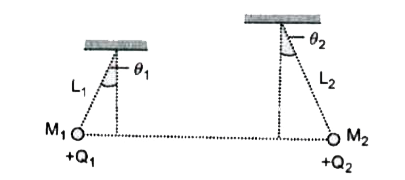The radiation corresponding to 3→2 transition of hydrogen atom falls on a metal surface to produce photoelectrons. These electrons are made to enter a magnetic field of 3×10−4T. If the radius of the largest circular path followed by these electrons is 10.0 mm, the work function of the metal is close to :Solution in Kannada
1.6 eV
1.8 eV
1.1 eV
0. 8 eV
The correct Answer is:C
r=mveB⇒r2e2B22=m2v22
r2e2B22m=mv22
Now hv=ϕ+1/2mv2
1.89=ϕ+1/2mv2
∴1.89−ϕ=r2e2B22m1eeV=r2e22meV
=100×10−6×1.6×10−19×9×10−82×9.1×10−31
Work function ϕ=1.89−1.6×92×9.1
=1.89−0.79≅eV
Topper's Solved these Questions
- ELECTRONS & PHOTONSBOOK - MODERN PUBLICATIONCHAPTER - ELECTRONS & PHOTONSEXERCISE - RECENT COMPETITIVE QUESTIONS
20 Videos
- ELECTRONS & PHOTONSBOOK - MODERN PUBLICATIONCHAPTER - ELECTRONS & PHOTONSEXERCISE - MULTIPLE CHOICE QUESTIONS (LEVEL-II)
63 Videos
- ELECTROMAGNETIC WAVESBOOK - MODERN PUBLICATIONCHAPTER - ELECTROMAGNETIC WAVESEXERCISE - RECENT COMPETITIVE QUESTIONS
4 Videos
- ELECTROSTATICSBOOK - MODERN PUBLICATIONCHAPTER - ELECTROSTATICSEXERCISE - RECENT COMPETITIVE QUESTIONS
39 Videos
Similar Questions
According to Einstein's photoelectric equation the graph of K.E. of the photoelectron emitted from the metal versus the frequency of the incident radiation gives a straight line graph whose slope
View SolutionMaximum frequency of the photon produced by the union of a proton and a antiproton is (given : mp=1.67×10−27kg):
View SolutionThe speed of electromagnetic wave in vacuum depends upon the source of radiation
View SolutionTwo small spheres of masses M1andM2 are suspended by weightless insulating threads of lengths L1andL2 The spheres carry charges Q1andq2 respectively . The spheres are suspended such that they are in level with one another and the threads are inclined to the vertical at angles of θ1andθ2 as shown . Which one o fthe following conditions , if θ1=θ2 ?

View SolutionThe radiation corresponding to 3→2 transition of hydrogen atom falls on a metal surface to produce photoelectrons . These electrons are made to enter circuit a magnitic field 3×10−4T if the ratio of thelargest circular path follow by these electron is 10.0 mm , the work function of the metal is close to
View Solutionहाइड्रोजन परमाणु के 3→2 संक्रमण के संगत विकिरण प्रकाशिक इलेक्ट्रॉन उत्पन्न के लिए धात्विक सतह पर गिरती है। ये इलेक्ट्रॉन चुम्ब्कीय क्षेत्र 3×10−4 T में प्रवेश करते हैं। यदि इन इलेक्ट्रॉनों द्वारा अनुसरित उच्चतम वृत्तीय पथ की त्रिज्या 10.0 मिमी है, तब धातु का कार्य फलन लगभग है :
View SolutionRadiation, with wavelenght 651Å falls on a metal surface to produce photoelectrons. The electrons are made to enter a uniform magnetic field of 3×10−4T. If the radius of the largest circular path followed by the electrons is 10 mm, the work function of the metal is close to:
View SolutionH− परमाणु में 3→2 के संक्रमण के संगत उत्पन्न विकिरण को धातु सतह पर आपतित करके प्रकाश इलेक्ट्रॉन उत्पन्न करते हैं । इस इलेक्ट्रॉन को 3×10−4T के चुबंकीय क्षेत्र से गुजारते हैं । यदि इस इलेक्ट्रॉन व्दारा अपनाई गई वृत्ताकार मार्ग की त्रिज्या 10mm हैं , तब धातु का कार्य -फलन होगा -
View SolutionThe radiation corresponding to 3 to 2 transition of hydrogen atom falls on a metal surface to produce photoelectron . These electrons are made to enter a magnetic field of 3xx10^(-4) T. if the radius of the largest circular path followed by these electrons in 10/0 mm, the work function of the metal is close to
View SolutionPhoto-electrons are produced from a metal surface using a radiation of wavelength 6561Å . These photo-electrons, when made to enter a uniform magnetic field of intensity 3×10−4 T, move along different circular paths with a maximum radius of 10mm, then the work function of the metal is close to
View SolutionRadiation corresponding to the transition n = 4 to n = 2 in hydrogen atoms falls on a certain metal( work function = 2.0 eV ). The maximum kinetic energy of the photoelectrons will be :
View SolutionThe radiation emitted when an electron jumps from n=3 to n = 2 orbit in a hydrogen atom, falls on a metal to produce photoelectron. The electron with maximum kinetic energy are made to move perpendicular to a magnetic field of (1)/(320) T in a radius of 10^(m) . The work function of the metal is :
View SolutionThe radiation corresponding to 3→2 transition of hydrogen atom falls on a metal surface to produce photoelectrons.These electrons are made to enter a magnetic field of 3×10−4T.If the radius of the largest circular path followed by these electrons is 10.0 mm the work function of the metal is close to:
View SolutionThe radiation corresponding to 3 rarr 2 transition of hydrogen atom falls on a metal surface to produce photoelectrons . These electrons are made to enter circuit a magnetic field 3 xx 10^(-4) T if the ratio of the largest circular path follow by these electron is 10.0 mm , the work function of the metal is close to
View SolutionRadiation, with wavelenght 6561Å falls on a metal surface to produce photoelectrons. The electrons are made to enter a uniform magnetic field of 3×10−4T. If the radius of the largest circular path followed by the electrons is 10 mm, the work function of the metal is close to:
View Solution
